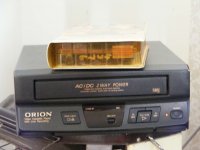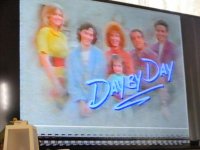PS Scott-
He was also a huge believer in those Sony Trinitrons. And, I have to agree even with the new Sony flat screens. Their technology just seems to feel more like real life, while others seem..... the best way I can describe it is “alien” or “soulless” like it’s the invasion of the body snatchers happening in frame.
I’m not really a big brand loyalist, and not only advocating Sony obviously, but I’ve noticed specifically that their products have a much different method which I perceive as more lifelike. I’m curious if you could chime in as to why you think it’s so different from other manufacturers.
Also, I don’t believe it’s just settings. I went into a video forum and went ham on adjusting and fine tuning two other different (and well reviewed) models from other manufacturers before returning them and going with the Sony. I think it’s my all time record for a store return saga of any kind.
Maybe those who don’t see what I see have already been “body snatched” and it’s just downhill from here ;-)
He was also a huge believer in those Sony Trinitrons. And, I have to agree even with the new Sony flat screens. Their technology just seems to feel more like real life, while others seem..... the best way I can describe it is “alien” or “soulless” like it’s the invasion of the body snatchers happening in frame.
I’m not really a big brand loyalist, and not only advocating Sony obviously, but I’ve noticed specifically that their products have a much different method which I perceive as more lifelike. I’m curious if you could chime in as to why you think it’s so different from other manufacturers.
Also, I don’t believe it’s just settings. I went into a video forum and went ham on adjusting and fine tuning two other different (and well reviewed) models from other manufacturers before returning them and going with the Sony. I think it’s my all time record for a store return saga of any kind.
Maybe those who don’t see what I see have already been “body snatched” and it’s just downhill from here ;-)
I’m not really a big brand loyalist, and not only advocating Sony obviously, but I’ve noticed specifically that their products have a much different method which I perceive as more lifelike. I’m curious if you could chime in as to why you think it’s so different from other manufacturers.
For one thing the CEO Akio Morita was directly involved in the quality of the product. When I went to visit SONY in 1988 I was told his personal listener chose the AD712 for their top end CD players. This was nice, neither here nor there today.
As for the TV's I think they used more expensive rare earth phosphors that gave a more naturalistic image. I have made this comment for over 40yrs. to numerous people mostly to deaf ears (blind eyes?). A still of a Japanese garden, for instance, could be rendered just right or maybe just so much better to my eyes than on any other monitor with any amount of adjustment. There was an established reference monitor made by Conrac which I never saw but it was $$$.
I find it ironic that folks here go on and on about preserving what the recording engineer wanted to present, but with video that all goes out the window. There is a lot of stuff on the web from professionals in the film industry and film lovers, even going over 24fps is considered a compromise.
The proposal was to coat 2" tape with DVDR material and run it at insane inches per second past a special laser scanner, frankly the whole thing seemed pie in the sky to me.
Sounds like the tape recorder from the Sci-Fi movie Brainstorm to me. If that is the case then I say, bring it on!
I must say it is a strange experience seeing Louise Fletcher pulling back on a smoke.
We really need an extremely high bandwidth storage medium right now.
Last edited:
A lady I know called Lucy transcribes 405 line TV for the BBC. She also works with more modern formats. To her the very best colour she ever saw was 1966( ish ) was NTSC tapes on NTSC monitors which were then converted to PAL. She thought the converted transmission a pale imitation. I though I had some NOS Sony 405 gear for her, alas no as someone had dumped it. I suspect is was from 1964. The machines looked like the latter 625 line machines. I seem to remember the spool had to be swapped to rewind it, most likely that's wrong.
I recently found a VHS machine for a friend. Having nothing better than Vodka I cleaned the heads ( toilet paper, sound only before cleaning took a risk as toilet paper can ruin the head , Sony used chamois on like a lolly stick ). Not only did it work but the Sony HD TV loved it. Whilst not to a high standard it was very enjoyable and the best VHS I have seen. Perhaps Bravia is part of that? Fireball XL5 being a favorite.
I recently found a VHS machine for a friend. Having nothing better than Vodka I cleaned the heads ( toilet paper, sound only before cleaning took a risk as toilet paper can ruin the head , Sony used chamois on like a lolly stick ). Not only did it work but the Sony HD TV loved it. Whilst not to a high standard it was very enjoyable and the best VHS I have seen. Perhaps Bravia is part of that? Fireball XL5 being a favorite.
By the way LTO-12 is expected to reach 200TB capacity by the time LTO-12 comes around.
LTO Consortium Pushes Roadmap To Gen 12 - IT Jungle
Also compatability between LTO-8 drives and LTO-6 tapes is broken.
LTO Consortium Pushes Roadmap To Gen 12 - IT Jungle
Also compatability between LTO-8 drives and LTO-6 tapes is broken.
But how do I know that LTO-9 will read LTO-7?
The two generations of backward compatibility was broken for LTO-8 because LTO-8 drives relies entirely on Barium Ferrite tape media. Since LTO-6 supported both magnetic particle and Barium Ferrite, the compatibility issues has arisen. This is not a likely scenario for LTO-9.
Attachments
Last edited:
We really need an extremely high bandwidth storage medium right now.
Already exists if you have the $$
I always thought Beta had a better picture than VHS. It was a sad day when VHS displaced Sony Beta and Beta-max. Sony technology was great, marketing was not a strong point of Sony (keep it all for ourselves).
People flocked to the 6hr VHS tapes, SONY did not get that the vast majority of the market did not care about quality. BTW the Panasonic NV series of VHS at slow speed was pretty good, pre-recorded tapes done at 1x on rooms full of NV7200's looked better than the Beta equivalents since IIRC no one released movies on the lowest Beta speed which used at least 2 tapes for any movie. By the time hi-speed duping became the norm I was less interested.
Says it all...
UbuWeb is pleased to present thousands of avant-garde films & videos for your viewing pleasure. However, it is important to us that you realize that what you will see is in no way comparable to the experience of seeing these gems as they were intended to be seen: in a dark room, on a large screen, with a good sound system and, most importantly, with a roomful of warm, like-minded bodies.
However, we realize that the real thing isn't very easy to get to. Most of us don't live anywhere near theatres that show this kind of fare and very few of us can afford the hefty rental fees, not to mention the cumbersome equipment, to show these films. Thankfully, there is the internet which allows you to get a whiff of these films regardless of your geographical location.
We realize that the films we are presenting are of poor quality. It's not a bad thing; in fact, the best thing that can happen is that seeing a crummy shockwave file will make you want to make a trip to New York to the Anthology Film Archives or the Lux Cinema in London (or other places around the world showing similar fare). Next best case scenario will be that you will be enticed to purchase a high quality DVD from the noble folks trying to get these works out into the world. Believe me, they're not doing it for the money.
Says it all...
Our university built a special theater with full facilities for historical cinema.
About | Cinematheque
We have Sony Trinitron bought in 2001 still working; (Repaired only twice) so didn't feel need to replace it.
-x-
How do modern digital tuners compare to old analogue ones ? Do they perform well for analogue radio broadcasts ? I know vintage Lights and Dials are quite alluring but we have progressed so Digital Tuners must be better than old Tuners.
-x-
How do modern digital tuners compare to old analogue ones ? Do they perform well for analogue radio broadcasts ? I know vintage Lights and Dials are quite alluring but we have progressed so Digital Tuners must be better than old Tuners.
I always thought Beta had a better picture than VHS. It was a sad day when VHS displaced Sony Beta and Beta-max. Sony technology was great, marketing was not a strong point of Sony (keep it all for ourselves).
Actually they appear to have made a vested interest in keeping the latest features and technology away from the US market, deliberately. THE RISE AND FALL OF BETA
I would not be surprised if snobbery at Sony is the root cause of all of Betamax's failures:
The Sony executive looked at me warily. In heavily — accented English, he explained, patiently, as if to a schoolchild: “We think adding remote pause to our video recorder would be a mistake. People might over — use it and create technical problems, wearing out their video heads too soon. No. This would be a bad idea.”
The year was 1978, and I was talking to a Sony vice-president at my very first Consumer Electronics Show about what I per*ceived was a short-sighted attitude in their product-planning department. I gestured wildly. “But look at that new machine over there from RCA! They’ve got remote pause and a built-in timer! And audio dub, too!” The executive looked bored. “Having separate timer allows the consumer to use it for other purposes. And not everyone needs timer. We do not force you to buy one.”
This was getting nowhere fast. I began to plead. “Are you saying that RCA, for all their years of marketing expertise, doesn’t know the home video market as well as you do?” I glared at him, almost out of breath. The Sony executive smiled icily. “We think we know best.”
I don’t know where this clown is working today, but we can only pray it’s not in home video.
The issues of the remote pause control and built-in timer were obvious to anyone who studied the products in any detail. Each feature was simple to produce and cost pennies on the assembly line. RCA was also the first to realize the importance of multi-event timers with the VCT-400, which could record four different events over a one-week period. Although this product ultimately proved to be unreliable because of the lack of a power back-up for the clock (a flaw later rectified with the VCT- 400X), consumers took to this new development instantly. Multi-event timer programming quickly became a standard feature of deluxe VHS decks, but perhaps because of a NIH (“not invented here”) philosophy, it took Sony nearly two years to market a multi-event timer-equipped VCR, which was their SL-5600.
Sony often took a back seat in inaugurating other convenience features, too, beginning with audio/video inputs. These jacks were deliberately omitted from the original SL-7200 Beta deck in order to give the more expensive LV-1901 console a competitive advantage. Eventually, consumer demand forced them to reluctantly add this feature with the revised SL-7200A. Another feature was audio dub, which was offered on virtually every VCR Sony released in all other parts of the world, including the Japanese versions of the 7200, but it was years before it was offered in the U.S. Again, the overwhelming opinion was that one more knob might be too much for our simple American minds to manage.
Anyone in the audio industry was also quick to see the superiority of the front-load*ing cassette hatch, which made top-loading audio decks obsolete almost overnight. This first appeared on Sharp’s VC-6800 in the fall of 1980 and quickly became a standard fea*ture in every VCR on the market, regardless of price. Sony followed with a front- loading Betamax a year later. The same problem repeated itself with solenoid-assisted transports and full-function remote control, which first appeared in industrial and professional video decks in the early 1970s. Despite the ergonomic elegance of solenoid transports, it was Mitsubishi, not Sony, who first introduced a consumer VCR with this feature in mid-1979, with their trend-setting HS-300. Two full years elapsed before Sony finally offered a solenoid-transport VCR, the SL-2500, which also boasted full wireless infrared remote.
In all fairness, we must point out that since the beginning, Sony was virtually alone in devoting time and money for R&D on new developments for Beta, while VHS had the considerable resources of Hitachi, JVC, Matsushita, Mitsubishi, and the others in the VHS family. Still, Sony’s failure to realize the importance of these features continued to snowball well into the mid-1980’s, and by then, it was much too late.
Last edited:
Our university built a special theater with full facilities for historical cinema.
About | Cinematheque
We had 3, I spent more time involved in this than what I was supposed to be doing. Two were full 35/16 and were sometimes booked by majors for press reviews. They have converted all to video AFAIK.
I think a base issue was that Sony was greedy and tried to keep Beta (and the market) to itself by refusing to share the technology with third parties. The VHS consortium resulted in a less expensive option from multiple vendors with more functions. Walk into a dealer and there would be two or three Sony units, and a dozen VHS units.
I think a base issue was that Sony was greedy and tried to keep Beta (and the market) to itself by refusing to share the technology with third parties.
It sort of worked for Trinitron as the goto high end TV, I expect they sought to repeat this. Refusing to license patents might bother some but that's the way things work which is a different issue.
I think a base issue was that Sony was greedy and tried to keep Beta (and the market) to itself by refusing to share the technology with third parties.
Yeah they didn't want to share with anyone that is the issue lol. Sony has a huge issue with sharing technology with anyone, they did that to themselves with many other formats as well. You think they would've learned but frankly I'm glad that they didn't what with all of the copy protection that they added to their digital products and their insane aptitude for making proprietary formats that won't work with anything else such as memorystick for one example.
Betamax, DAT, Minidisc, ATRAC (*shivver*), UMD.
That speaks volumes more about the television than it does the VCR. You can get 6 head VCR's with really good high quality DVD-like pictures provided you are willing to play it back on a Plasma or CRT. What with their digital noise reduction and *cough* digital comb filter a LCD screen will produce a terrible picture by default. If you play it back with a 2-head VCR you will get a picture much like the one I've attached below.I never owned a Betamax VCR but I'm pretty sure they were technically superior ( more bandwidth I think )
If you want to see the true horror of VHS connect one up to an HDTV preferably via the RF input !
The 2-head Orion VCR that I've got a picture of below produced the following pictures attached, which are all on my mums cheap LCD screen, not the greatest picture that I can produce, I will attach further pictures later on this afternoon of the picture quality that I can get with a 51cm Trinitron screen and a 6-head VCR.
Today in 10 hours time I'm planning on driving 75km to go and pick up 100+ pre-recorded "blank" VHS tapes with content on them for cheap from a seller.
I'm archiving all of the old shows and ads that I used to watch on tv as a kid into MPEG-2 via a capture card. Quite a few shows I used to watch on australian tv were actually made by French media firms, such as Orson & Olivia and Mission: Top Secret among others. You can't get these shows on DVD.
Attachments
Last edited:
If you want to see the true horror of VHS connect one up to an HDTV preferably via the RF input !
Sort of not fair putting a deliberate impairment in the chain S video and RGB component I/O's existed.
The shortage of source material in the correct aspect ratio would make any of the tape formats a no go for me.
Just drove back home with 200x VHS tapes in the back of my mums wagon... 
I will be digitizing them into MPEG-2 or MPEG-4 (Still going to do some tests involving handbrake) and then throwing the VHS tapes out or selling them on to others on facebook. I don't have the room for that many VHS tapes, doubt anyone would lol.
I will be only keeping Betamax tapes and a few select laserdiscs from now on.
I will be digitizing them into MPEG-2 or MPEG-4 (Still going to do some tests involving handbrake) and then throwing the VHS tapes out or selling them on to others on facebook. I don't have the room for that many VHS tapes, doubt anyone would lol.
I will be only keeping Betamax tapes and a few select laserdiscs from now on.
Last edited:
One of the major reasons for VHS popularity over Sony Beta was the then issue of Beta head disc alignment.
The earlier Beta head discs were located/locked by screws once the disc was positioned correctly to microns tolerance using a dial runout gauge.
Trouble was, final tightening of the screws shifted the head disc back out of alignment.....sometimes this worked out first go, usually several attempts were required.
After the head disc was correctly fitted, the upper stationary drum had to be fitted.
Later Beta heads assemblies did not require fine adjustment but too late into the game.
VHS totally sidestepped this issue....drop in new head drum, tighten screws, solder connections, tweak guides, game over.
The Beta U-Load tape path was also more critical of pressure roller condition and guides alignment.
This all added to Beta servicing costs and aided the dominance of the much easier to maintain VHS tape mechanism.
Dan.
The earlier Beta head discs were located/locked by screws once the disc was positioned correctly to microns tolerance using a dial runout gauge.
Trouble was, final tightening of the screws shifted the head disc back out of alignment.....sometimes this worked out first go, usually several attempts were required.
After the head disc was correctly fitted, the upper stationary drum had to be fitted.
Later Beta heads assemblies did not require fine adjustment but too late into the game.
VHS totally sidestepped this issue....drop in new head drum, tighten screws, solder connections, tweak guides, game over.
The Beta U-Load tape path was also more critical of pressure roller condition and guides alignment.
This all added to Beta servicing costs and aided the dominance of the much easier to maintain VHS tape mechanism.
Dan.
- Status
- This old topic is closed. If you want to reopen this topic, contact a moderator using the "Report Post" button.
- Home
- Member Areas
- The Lounge
- Why?




